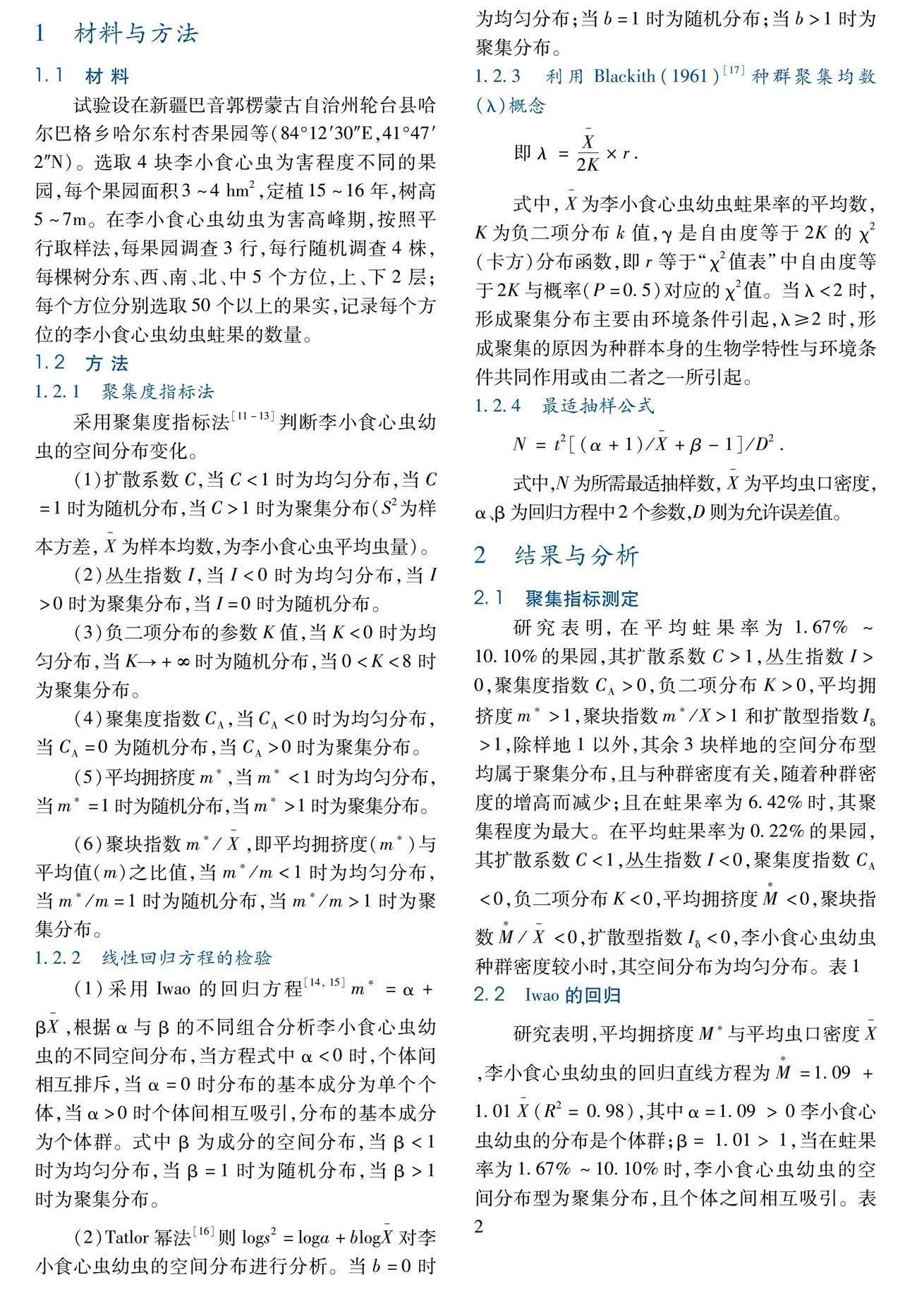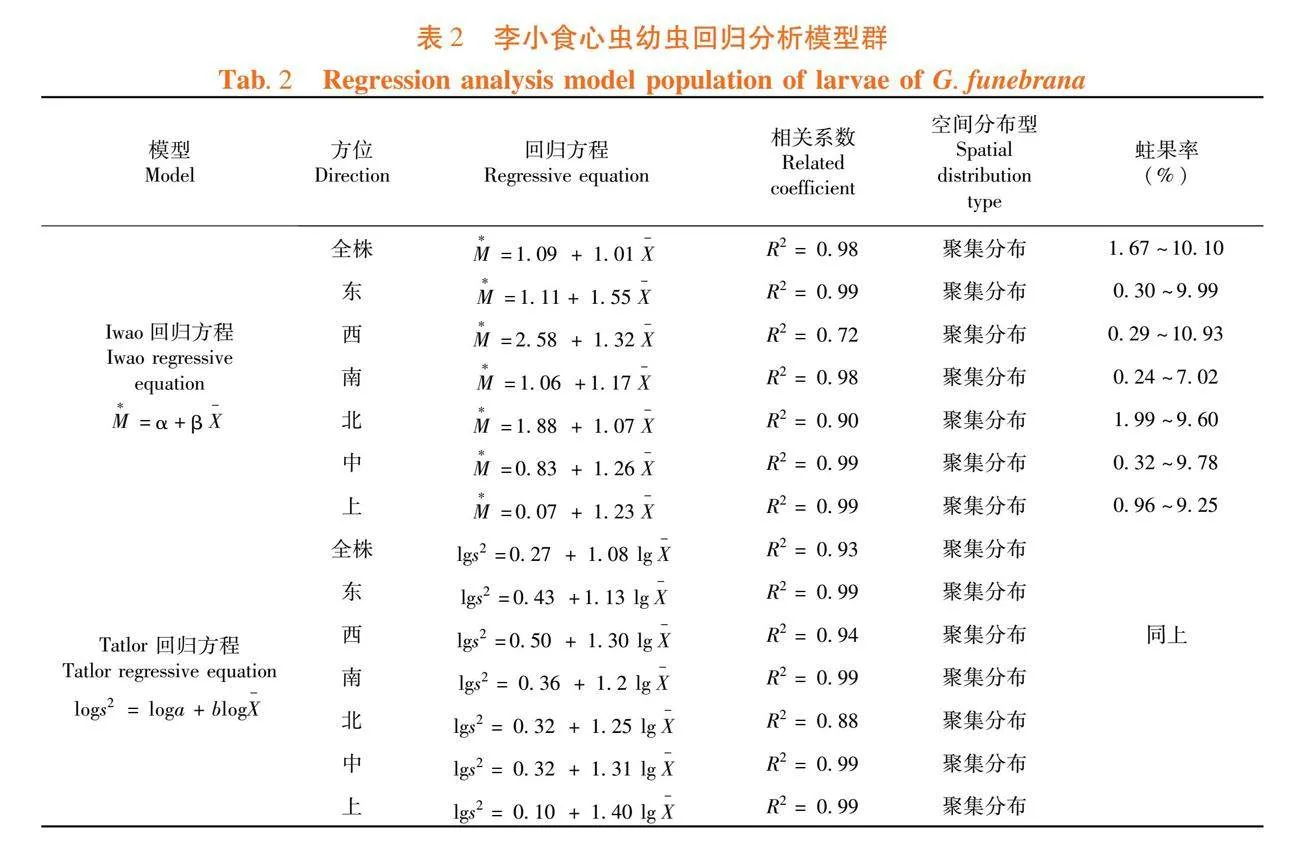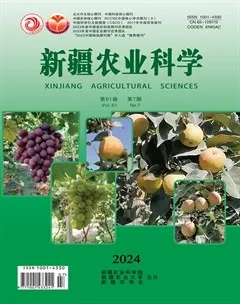李小食心虫在果园的空间分布变化及其最适抽样数的分析
2024-12-31刘雨萍徐兵强宋博李海强陈浩宇郝敬喆朱晓锋任金龙





摘 要:【目的】研究李小食心虫(Grapholitha funebrana Treitscheke)幼虫在果园的空间分布,为李小食心虫的科学防控及确定最适抽样数提供理论依据。
【方法】采用聚集指标法、Iwao回归分析、Taylor幂法则和Iwao最适抽样模型等方法,研究李小食心虫空间分布规律及确定其最佳抽样数。
【结果】李小食心虫幼虫空间分布型与种群密度有关,在调查范围内(蛀果率在0.22%~10.10%),随着种群密度的增加其空间由均匀分布向聚集分布转变,蛀果率在0.22%时为均匀分布,蛀果率在1.67%~10.10%时为聚集分布,该变化是其生活习性和环境条件所引起的;确定了不同种群密度和允许误差下的最适抽样数。
【结论】随着李小食心虫幼虫种群密度的增加其空间分布亦由均匀分布向聚集分布转变;对于李小食心虫聚集分布的果园(蛀果率gt;1.67%的果园),应重点防治为害严重株或部位,有效控制该虫的扩散。
关键词:李小食心虫;果园;空间分布;抽样技术
中图分类号:S43"" 文献标志码:A"" 文章编号:1001-4330(2024)07-1772-06
0 引 言
【研究意义】李小食心虫(Grapholitha funebrana Treitscheke)属于鳞翅目小卷叶蛾科[1-3],为蛀果害虫,主要以幼虫啃食果肉及果树嫩梢[4]。该虫在我国已知分布于东北、华北、西北及南方果树种植区,在1996年以来新疆果树李小食心虫的种群数量逐年增多,为害严重时,蛀果率可达80%~90%[5];近年来有为害核桃果实的现象。研究李小食心虫幼虫的空间分布,对有效控制其为害的发生与蔓延及安全高效防治与监测有实际意义。昆虫的空间分布型是种群的一个重要特征之一,研究昆虫的空间分布能够揭示其种群动态结构和田间发生规律,对其虫情的预测预报、防治阈值确定、防治策略制定等有重要意义。
【前人研究进展】孙勇等[6]在李小食心虫的分布、寄主、鉴定等方面总结了李小食心虫的研究进展,杨磊等[7]通过统计李小食心虫诱集数量,明确了李小食心虫成虫的活动规律。【本研究切入点】有文献研究了李小食心虫在寄主植物上的种群特征和消长规律[8-10]。在李小食心虫空间分布和抽样技术方面虽然有研究和报道,但是在抽样法上比较繁琐,在生产运用中专业性较强,难以被掌握和运用。以往对李小食心虫的研究多集中于在为害特点、生物学特性及综合防控措施等方面,其研究尚有许多薄弱环节,需研究快速、有效的对该种群研究数据进行正确判断,改进抽样技术方法。【拟解决的关键问题】在新疆轮台县果园对李小食心虫幼虫的空间分布格局和抽样技术与方法进行研究,分析蛀果率与幼虫数量的变化规律,为李小食心虫的科学的预测预报和高效防治提供依据。
1 材料与方法
1.1 材 料
试验设在新疆巴音郭楞蒙古自治州轮台县哈尔巴格乡哈尔东村杏果园等(84°12′30″E,41°47′2″N)。选取4块李小食心虫为害程度不同的果园,每个果园面积3~4 hm2,定植15~16年,树高5~7m。在李小食心虫幼虫为害高峰期,按照平行取样法,每果园调查3行,每行随机调查4株,每棵树分东、西、南、北、中5个方位,上、下2层;每个方位分别选取50个以上的果实,记录每个方位的李小食心虫幼虫蛀果的数量。
1.2 方 法
1.2.1 聚集度指标法
采用聚集度指标法[11-13]判断李小食心虫幼虫的空间分布变化。
(1)扩散系数C,当C<1时为均匀分布,当C=1时为随机分布,当C>1时为聚集分布(S2为样本方差,X-为样本均数,为李小食心虫平均虫量)。
(2)丛生指数I,当I<0时为均匀分布,当I>0时为聚集分布,当I=0时为随机分布。
(3)负二项分布的参数K值,当K<0时为均匀分布,当K→+∞时为随机分布,当0<K<8时为聚集分布。
(4)聚集度指数CA,当CA<0时为均匀分布,当CA=0为随机分
布,当CA>0时为聚集分布。
(5)平均拥挤度m*,当m*<1时为均匀分布,当m*=1时为随机分布,当m*>1时为聚集分布。
(6)聚块指数m*/X-,即平均拥挤度(m*)与平均值(m)之比值,当m*/m<1时为均匀分布,当m*/m=1时为随机分布,当m*/m>1时为聚集分布。
1.2.2 线性回归方程的检验
(1)采用Iwao的回归方程[14, 15]m*=α+βX-,根据α与β的不同组合分析李小食心虫幼虫的不同空间分布,当方程式中α<0时,个体间相互排斥,当α=0时分布的基本成分为单个个体,当α>0时个体间相互吸引,分布的基本成分为个体群。式中β为成分的空间分布,当β<1时为均匀分布,当β=1时为随机分布,当β>1时为聚集分布。
(2)Tatlor幂法[16]则logs2=loga+blogX-对李小食心虫幼虫的空间分布进行分析。当b=0时为均匀分布;当b=1时为随机分布;当bgt;1时为聚集分布。
1.2.3 利用Blackith(1961)[17]种群聚集均数(λ)概念
即λ=X-2K×r.
式中,X-为李小食心虫幼虫蛀果率的平均数,K为负二项分布k值,γ是自由度等于2K的χ2(卡方)分布函数,即r等于“χ2值表”中自由度等于2K与概率(P=0.5)对应的χ2值。当λ<2时,形成聚集分布主要由环境条件引起,λ≥2时,形成聚集的原因为种群本身的生物学特性与环境条件共同作用或由二者之一所引起。
1.2.4 最适抽样公式
N=t2[(α+1)/X-+β-1]/D2.
式中,N为所需最适抽样数,X-为平均虫口密度,α、β为回归方程中2个参数,D则为允许误差值。
2 结果与分析
2.1 聚集指标测定
研究表明,在平均蛀果率为1.67%~10.10%的果园,其扩散系数Cgt;1,丛生指数Igt;0,聚集度指数CAgt;0,负二项分布Kgt;0,平均拥挤度m*gt;1,聚块指数m*/Xgt;1和扩散型指数Iδgt;1,除样地1以外,其余3块样地的空间分布型均属于聚集分布,且与种群密度有关,随着种群密度的增高而减少;且在蛀果率为6.42%时,其聚集程度为最大。在平均蛀果率为0.22%的果园,其扩散系数Clt;1,丛生指数Ilt;0,聚集度指数CAlt;0,负二项分布Klt;0,平均拥挤度M*lt;0,聚块指数M*/X-lt;0,扩散型指数Iδlt;0,李小食心虫幼虫种群密度较小时,其空间分布为均匀分布。表1
2.2 Iwao的回归
研究表明,平均拥挤度M*与平均虫口密度X-,李小食心虫幼虫的回归直线方程为M*=1.09 + 1.01X-(R2 = 0.98),其中α=1.09 gt; 0李小食心虫幼虫的分布是个体群;β= 1.01gt; 1,当在蛀果率为1.67%~10.10%时,李小食心虫幼虫的空间分布型为聚集分布,且个体之间相互吸引。表2
2.3 Tatlor幂法则
研究表明,在Tatlor的回归方程中lgs2 = 0.27 + 1.08lgX-(R2 = 0.93)检验中不同方位的lga= 0.27gt; 0、b= 1.08gt; 1,李小食心虫幼虫空间分布为聚集分布,且与种群密度有关,聚集程度随X-值的增大而增加。表2
2.4 聚集原因
采用Blackith提出种群聚集均数(λ)概念,测定李小食心虫幼虫在4块样地的杏果上的聚集均数(λ),4块样地的λ值均大于2,因此,证明李小食心虫幼虫聚集分布的原因由其昆虫本身聚集习性或环境条件引起。
2.5 李小食心虫幼虫的理论抽样数
研究表明,在相同的蛀果率下,最适抽样量随着允许误差的增加而减少;在相同的允许误差下,随着幼虫蛀果率的增大最适抽样量也随之而减少。表4
3 讨 论
3.1
研究采用了目前常用的聚集度指标法和两种回归模型分析法,确定了李小食心虫幼虫的空间分布型主要为聚集型分布或均匀分布,该结果
与刘军和[8, 18]的李小食心虫幼虫在美国杏李上的研究基本一致,但李小食心虫幼虫在新疆轮台县的空间分布与种群密度有关,种群密度小的为均匀分布与刘军和的研究有所不同。与陆爽[19]、王慧[20]等对梨小食心虫的空间分布型的研究中呈聚集分布的结论基本一致。李小食心虫幼虫在杏树上聚集分布的原因与昆虫的生活环境有关,受环境条件的影响,该结论与李锐等[21]对梨小食心虫的研究结论基本相同。
3.2
研究选定的4块样地中,树种、树龄以及栽培管理模式等因素均存在一定的差异性,通过空间分布模型分析和聚集度指标测定看出,其种群密度之间存在明显差异,随着种群密度的增大,其空间分布型有均匀-聚集-均匀的趋势。此外,试验研究只调查了0.22%~10.10%的蛀果率,蛀果率gt; 10.10%的果园里的李小食心虫空间分布有待进一步研究。
4 结 论
李小食心虫的田间空间分布与种群密度相关,随着种群密度的增加其空间分布由均匀分布向聚集分布转变,聚集习性和环境条件是其聚集的主要原因;对于李小食心虫聚集型分布的果园(蛀果率gt;1.67%的果园),应重点防治为害严重株或部位,是有效控制该虫的扩散、为害的关键;对于李小食心虫均匀分布的果园,虫口密度较小,蛀果率较低(蛀果率lt;1.67%),应以加强全园的预防为主,有效控制其为害与蔓延。
参考文献(References)
[1]
吴维钧. 两种果树害虫——旋纹潜叶蛾及李小食心虫[J]. 昆虫学报, 1961, 4(S1): 395-400.
WU Weijun. Two kinds of fruit tree pests: Swirling leaf moth and plum small heartworm [J]. Acta Entomologica Sinica, 1961, 4(S1): 395-400.
[2] 杨长群, 王建春, 石永理, 等. 美国杏李果实食心虫无公害防治技术[J]. 果农之友, 2006, (11): 31.
YANG Changqun, WANG Jianchun, SHI Yongli, et al. Pollution-free control technology of Fruit-eating worm in Apricot and plums in the United States [J]. Fruit Growers’ Friend, 2006, (11): 31.
[3] 李芳东, 孙志强, 杜红岩, 等. 杏李产区病虫害发生危害调查及防治[J]. 中国果树, 2007, (5): 55-57.
LI Fangdong, SUN Zhiqiang, DU Hongyan, et al. Investigation and control of pests and diseases in apricot and plum producing areas [J]. China Fruits, 2007, (5): 55-57.
[4] 王凡, 牛蛉磊, 吉光鹏, 等. 南疆图木舒克果园三种食心虫消长动态研究[J]. 新疆农垦科技, 2022, 45(4): 40-42.
WANG Fan, NIU Linglei, JI Guangpeng, et al. Study on the dynamics of three edible worms in Tumushuke orchards in southern Xinjiang [J]. Xinjiang Farm Research of Science and Technology, 2022, 45(4): 40-42.
[5] 王金华, 戴春红. 寒地果园李小食心虫危害特点及防治技术[J]. 农业开发与装备, 2014, (11): 114.
WANG Jinhua, DAI Chunhong. The harm characteristics and control technology of Lycophagia pectoralis in cold orchard [J]. Agricultural Development amp; Equipments, 2014, (11): 114.
[6] 孙勇, 李广伟, 徐世才. 李小食心虫的研究进展[J]. 延安大学学报(自然科学版), 2019, 38(2): 92-96, 102.
SUN Yong, LI Guangwei, XU Shicai. Progress in research onGrapholitha funebrana[J]. Journal of Yanan University (Natural Science Edition), 2019, 38(2): 92-96, 102.
[7] 杨磊, 孙惠敏, 林河州, 等. 石河子垦区果树食心虫种类及其种群动态[J]. 北方园艺, 2017, (12): 132-135.
YANG Lei, SUN Huimin, LIN Hezhou, et al. Species and population dynamics of fruit borer in Shihezi reclamation zone[J]. Northern Horticulture, 2017, (12): 132-135.
[8] 刘军和, 禹明甫. 李小食心虫幼虫在美国杏李上的空间分布格局[J]. 湖南农业科学, 2008, (5): 111-112, 115.
LIU Junhe, YU Mingfu. Study on Spatial Distribution Pattern ofGrapholitha funebranalarvae on “Meiguoxingli” Plum[J]. Hunan Agricultural Sciences, 2008, (5): 111-112, 115.
[9] 邢楚明, 韩冬银, 李磊, 等. 蓟马在芒果园田间的时空动态[J]. 环境昆虫学报, 2017, 39(6): 1258-1265.
XING Chuming, HAN Dongyin, LI Lei, et al. Spatio-temporal dynamics of thrips in mango orchard[J]. Journal of Environmental Entomology, 2017, 39(6): 1258-1265.
[10] 杜浩, 刘学敏, 高梅, 等. 菠萝蜜园黄翅绢野螟幼虫的空间分布格局和抽样技术[J]. 热带农业科学, 2020, 40(8): 50-54.
DU Hao, LIU Xuemin, GAO Mei, et al. Spatial distribution pattern and sampling plan ofDiaphania caesalislarvae inArtocarpus heterophyllusplantation[J]. Chinese Journal of Tropical Agriculture, 2020, 40(8): 50-54.
[11] 张孝羲. 昆虫生态及预测预报[M]. 北京: 中国农业出版社, 2001: 58-69.
ZHANG Xiaoxi. Insect Ecology and Prediction[M]. Beijing: China Agriculture Press, 2001:58-69.
[12] 徐汝梅. 昆虫种群生态学[M]. 北京: 北京师范大学出版社, 1987.
XU Rumei. Insect Population Ecology[M]. Beijing: Beijing Normal University Press, 1987.
[13] 朱晓锋, 阿布都克尤木, 徐兵强, 等. 杏树吐伦球坚蚧空间分布型及抽样技术研究[J]. 环境昆虫学报, 2009, 31(2): 102-106.
ZHU Xiaofeng, Abudukeyoumu, XU Bingqiang, et al. Study on the spatial distribution pattern and sampling technique ofRhodococcus turanicusArch. in apricot orchard[J]. Journal of Environmental Entomology, 2009, 31(2): 102-106.
[14] 兰星平. 关于Iwao m*-m回归模型在昆虫种群空间分布型的应用分析[J]. 贵州林业科技, 2007, 35(1): 1-8.
LAN Xingping. Analysis on the application of iwao’s m*-m model on the study of distribution pattern of insect population[J]. Guizhou Forestry Science and Technology, 2007, 35(1): 1-8.
[15] Iwao S. Application of the method to the analysis of spatial patterns by changing the quadrat sizemethod to the analysis of spatial patterns by changing the quadrat size[J]. Population Ecology, 1972, 14(1): 97-128.
[16] Taylor L. Assessing and interpreting the spatial distributions of insect populations[J]. Annual Review of Entomology, 1984, 29: 321-357.
[17] Blackith R E. The water reserves of hatchling locusts[J]. Comparative Biochemistry and Physiology, 1961, 3(2): 99-107.
[18] 刘军和. 李小食心虫种群空间格局的地统计学分析[J]. 河南大学学报(自然科学版), 2010, 40(2): 169-174.
LIU Junhe. The geostatistical analysis of population spatial patterns onGrapholita funebrana[J]. Journal of Henan University (Natural Science), 2010, 40(2): 169-174.
[19] 陆爽, 王笑. 梨小食心虫危害桃梢空间分布型研究[J]. 上海农业科技, 2010, (6): 76-77.
LU Shuang, WANG Xiao. Study on the spatial distribution pattern of peach shoots harmed by small edible worm of pear [J]. Shanghai Agricultural Science and Technology, 2010, (6): 76-77.
[20] 王慧,刘伟. 梨小食心虫为害桃梢的空间分布型及应用研究[J]. 落叶果树. 1991, 23(2): 14-15.
WANG Hui, LIU Wei. Study on the spatial distribution pattern and application of pear small food worm to peach shoots [J]. Deciduous Fruits, 1991, 23(2): 14-15.
[21] 李锐, 李喆, 赵志国, 等. 梨小食心虫幼虫为害桃梢的空间分布型[J]. 山西农业大学学报(自然科学版), 2010, 30(5): 409-412.
LI Rui, LI Zhe, ZHAO Zhiguo, et al. Study on spatial distribution ofGrapholitha molestalarvae in peach crown[J]. Journal of Shanxi Agricultural University (Natural Science Edition), 2010, 30(5): 409-412.
Study on the spatial distribution and sampling
technique of Grapholitha funebrana
LIU Yuping1,2, XU Bingqiang2, SONG Bo2, LI Haiqiang2,
CHEN Haoyu2, HAO Jingzhe2, ZHU Xiaofeng2, REN Jinlong1
(1.College of Agriculture, Xinjiang Agricultural University, Urumqi 830052, China;2. Key Laboratory of Integrated Pest Management on Crop in Northwestern Oasis/Ministry of Agriculture and Rural Affairs / National Local Joint Engineering Research Center of Special Forestry and Fruit Industry/Institute of Plant Protection,Xinjiang Academy of Agricultural Sciences,Urumqi 830091,China)
Abstract:【Objective】 To clarify the spatial distribution patterns and sampling techniques of Grapholitha funebrana Treitscheke larvae in orchards, so as to provide theoretical basis for scientific control, investigation and sampling of the insect.
【Methods】" The spatial distribution pattern and sampling technique were studied by means of aggregation index method, Iwao regression analysis, Taylor's power law and Iwao optimal sampling model.
【Results】 The spatial distribution pattern of larva was related to population density. With the increase of population density, the spatial distribution of larva changed from uniform distribution to aggregation distribution. The distribution of larva was uniform distribution when the rate of caries was 0.22%, and the distribution of larva was aggregatived when the rate of caries was 1.67%-10.10%. The causes of aggregation were caused by their living habits and environmental conditions. The optimum sampling number under different population densities and allowable errors was determined.
【Conclusion】 With the increase of population density, the spatial distribution of larva larvae changes from uniform distribution to aggregation distribution. For the orchards with aggregation distribution (fruit decay rate gt;1.67%), it is important to control the plant or the parts with serious damage, which is the key measure to effectively control the spread and damage of G. funebrana.
Key words:Grapholitha funebrana; orchard; spatial distribution; sampling technique
Fund projects:Key Ramp;D Program Project of Xinjiang Uygur Autonomous Region (2021B02004-1); Special Fund Project of Xinjiang Apricot Industrial Technology System (XJCYTX-03)
Correspondence author: ZHU Xiaofeng (1979-), male, professor, research direction: Integrated prevention and control of fruit diseases and pests, (E-mail)zxf5117@ 163. com
REN Jinlong,(1989-) male, Ph.D., associate professor, research direction: Insect taxonomy and Phylogeny, Insect-Plant Interaction, Insect diversity and distribution patterns in Steppe, (E-mail)rjlinsect@163.com
收稿日期(Received):
2024-02-03
基金项目:
新疆维吾尔自治区重点研发计划项目 (2021B02004-1);新疆杏产业技术体系专项资金项目(XJCYTX-03)
作者简介:
刘雨萍(1999-),女,四川成都人,硕士研究生,研究方向为农业昆虫与害虫防治,(E-mail)1342137706@qq.com
通讯作者:
朱晓锋(1979-),男,河南许昌人,研究员,博士,研究方向为果树病虫害综合防控,(E-mail)zxf5117@ 163. com
任金龙(1989-)男,甘肃人,副教授,博士,研究方向为昆虫分类和系统进化、昆虫与植物互作、草原昆虫多样性及分布格局机制,(E-mail)rjlinsect@163.com
